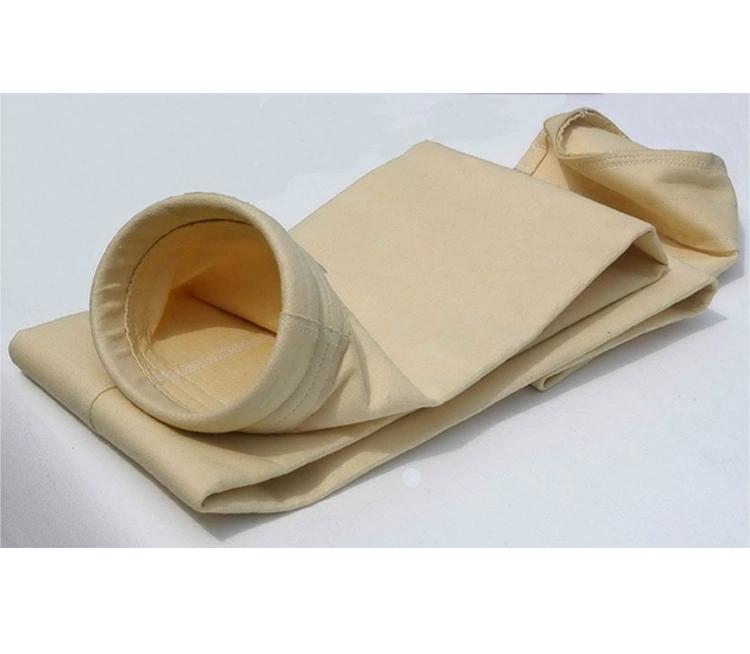A brief discussion on the wear analysis and troubleshooting of dust filter bags
2024-08-20
The dust removal efficiency of dust filter bags can be as high as 99.99%, so this high efficiency makes it the first in the dust removal industry. However, wear and tear are inevitable during use. This issue mainly talks about the wear analysis and troubleshooting of dust filter bags.
1. Wear and tear of the bag mouth of the dust collector filter bag:
The wear and tear of the bag mouth is mainly within 400 mm below the bag mouth, and the damage marks are mainly from the inside to the outside. The dust removal skeleton should be light and easy to install and maintain. The quality of the dust removal skeleton directly affects the filtering state and service life of the filter bag. The existing advanced dust removal skeleton manufacturing equipment uses a high-frequency welding machine to weld the skeleton into shape at one time, and uses iron wire or stainless steel wire with sufficient strength and steel. In the early stage of this wear and tear, it is mainly due to the compressed air blown back by the pulse that destroys the filter bag base and directly washes the side wall of the filter bag. Under the continuous erosion of the compressed air on the reverse side, the inner layer of the filter bag is first blown off by the compressed air, then blows out the base cloth, and finally blows out the filter membrane surface. When one side of the filter bag is damaged, the resistance of the damaged part is reduced, and the dust-containing flue gas quickly enters from the damaged part, obliquely scouring the damaged part, forming a new gap and a new dust-containing flue gas inlet, increasing the void ratio, and finally forming a ring-shaped damage to the bag mouth. In severe cases, it may even cause the bag head and the bag body to separate. This damage is mainly caused by factors such as high compressed air pressure, short nozzle tilt, and plate deformation. Once such wear is found, back washing should be performed before replacing the new bag.
2. Wear of the filter bag body
If the damage marks are damaged from the inside to the outside, and the damage is at the contact point of the vertical rod of the bag cage, it means that the vertical rod of the bag cage is desoldered or corroded, the filter bag is worn or the injection pressure is too high, and the injection frequency is too high. The dust bag is a dry high-efficiency dust collector. It is a dust removal device that uses a bag filter element made of fiber braid to capture solid particles in dust-containing gas. Its working principle is that dust particles are intercepted when they collide with the fiber due to the inertial force when they are around the filter cloth fiber. The contact angle between the filter bag and the bag cage is folded and broken to form damage. This wear problem can be solved by replacing the bag cage or adjusting the injection device.
If the damage marks are from the outside to the inside, the damage is caused at the contact of the vertical rod of the bag holder. It can usually be seen that the outside of the filter bag (adjacent filter bags or box components) has traces of grinding with the filter bag. This wear is the deformation of the bag cage or small filter bag device, the filter bag diameter is large or loose, resulting in the contact between the filter bag and the filter bag, and the filter bag and the dust box assembly. During the backflush process, the filter bags rub and wear against each other due to expansion. The bag cage usually needs to be replaced to ensure the quality of the device.
3. Mechanical wear of the lower part of the filter bag:
The external wear of the lower part of the filter bag is more common within 300 mm from the bottom of the filter bag. The wear is mainly on one side, the worst at the bottom, and gradually decreases upward. Some sewing threads will wear, and the strength of the sewing thread will not wear. This wear is mainly caused by deformation of the filter plate, small hole spacing, deformation of the bag cage, and excessive length of the filter bag. The single filter bag is damaged by friction with the wall of the dust collector box. This damage requires strict inspection of the level of the plate, and a well-made bag cage should be used. Wear on the bottom of the filter bag.
4. Wear on the outside of the bottom of the filter bag:
There are obvious signs of wear on the damaged surface. Wear on the bottom sewing thread and filter base cloth, when the bottom of the bag is severely damaged or falls off as a whole. This wear is caused by the high material content in the ash hopper, and the airflow directly flushes the dust particles into the bottom of the bag, forming wear. By increasing the ash discharge volume of the ash hopper and adjusting the ash discharge system of the dust collector, dust accumulation is avoided and the generation of eddy current wear on the filter bag is avoided. Internal friction of the dust bag.
The inner wall of the filter bag is damaged the most due to the large difference between the outer diameter of the bag cage and the inner diameter of the filter bag. The inner wall of the filter bag is wiped with the bag cage, the inner wall of the filter bag is rubbed with the inner wall of the filter bag, and the inner wall of the filter bag is rubbed with the inner wall of the filter bag. The inner wall of the filter bag is damaged due to the large difference between the outer diameter of the filter bag and the inner diameter of the filter bag. The friction and wear of the inner wall of the filter bag and the inner wall of the filter bag are large. The dust filter bag is a dry high-efficiency dust collector. It is a dust removal device that uses a bag filter element made of fiber woven fabric to capture solid particles in dust-containing gas. Its working principle is that dust particles collide with the fibers due to inertia when passing around the filter cloth fibers and are intercepted. When the filter bag is cleaned and the filter bag swings too much, the inner wall of the filter bag will wear.




